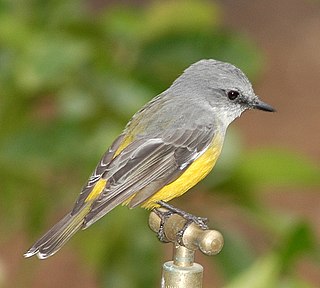Abelia is a formerly recognized genus that contained about 30 species and hybrids, placed in the honeysuckle family, Caprifoliaceae. Molecular phylogenetic studies showed that the genus was not monophyletic, and in 2013, Maarten Christenhusz proposed the merger of Abelia into Linnaea, along with some other genera. Abelia section Zabelia was raised to the genus Zabelia.

The yellow-footed antechinus, also known as the mardo, is a shrew-like marsupial found in Australia. One notable feature of the species is its sexual behavior. The male yellow-footed antechinus engages in such frenzied mating that its immune system becomes compromised, resulting in stress related death before it is one year old.

The western yellow robin, species Eopsaltria griseogularis, also known as bamborn or grey-breasted robin, is a species of bird in the family Petroicidae. It is endemic to Australia. where it is named bamborn in the southwest of the country..

Lasiopetalum is a genus in the family Malvaceae containing around 35 species of shrub, which are native to Australia.

Stackhousia is a genus of annual and perennial plants in the family Celastraceae that are native to Australia, New Zealand, Malesia and Micronesia. The genus was first described by James Edward Smith in Transactions of the Linnean Society of London in 1798.

Conostylis is a genus of perennial herbs in the family Haemodoraceae commonly known as cone flowers, endemic to the south west of Western Australia. They have leathery, strap-like leaves which arise from the base of the plant, sometimes from underground rhizomes. Flowers which usually occur in clusters on stalks which emerge from the bases of the leaves. Individual flowers have a short stalk with and six tepals which are either cream, yellow, orange or purple. The tepals join to form a short tube at the base with six similar stamens attached at the top of the tube.

Eragrostis dielsii, commonly known as mallee lovegrass, is a species of grass endemic to Australia.
Setaria dielsii, commonly known as Diels' pigeon grass, is a species of grass native to Australia.
Lifago is a genus of flowering plants in the spikenard tribe within the daisy family.
Stackhousia subterranea is a perennial herb species in the family Celastraceae. The species occurs in South Australia and Victoria and Tasmania

Stackhousia monogyna, commonly known as creamy stackhousia or creamy candles, is a perennial herb species in the family Celastraceae. It is native to Australia. Plants grow to 70 cm (28 in) high and produce a terminal spike of white, cream or yellow flowers between August and January in the species native range.
Acacia dielsii, commonly known as Diels' wattle, is a shrub of the genus Acacia and the subgenus Plurinerves that is native to Western Australia.
Eucalyptus dielsii, commonly known as the cap-fruited mallee, is a eucalypt that is native to Western Australia.

Stackhousia clementii is a species of plant in the Celastraceae family.
Stackhousia huegelii is a species of plant in the Celastraceae family.

Stackhousia muricata is a species of plant in the Celastraceae family.
Stackhousia pubescens, commonly known as downy stackhousia, is a species of plant in the Celastraceae family.
Stackhousia scoparia is a species of plant in the Celastraceae family.
Stackhousia stratfordiae is a species of plant in the Celastraceae family.
Stackhousia umbellata is a species of plant in the Celastraceae family.









